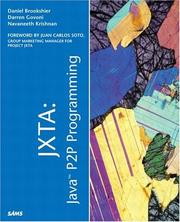| Listing 1 - 10 of 26 | << page >> |
Sort by
|
Book
ISBN: 1282287206 9786612287206 0080921191 0123742145 9780123742148 9780080921198 9781282287204 6612287209 9788131222492 8131222497 Year: 2009 Publisher: Amsterdam Boston Elsevier/Morgan Kaufmann
Abstract | Keywords | Export | Availability | Bookmark
 Loading...
Loading...Choose an application
- Reference Manager
- EndNote
- RefWorks (Direct export to RefWorks)
Peer-to-Peer (P2P) networks enable users to directly share digital content (such as audio, video, and text files) as well as real-time data (such as telephony traffic) with other users without depending on a central server. Although originally popularized by unlicensed online music services such as Napster, P2P networking has recently emerged as a viable multimillion dollar business model for the distribution of information, telecommunications, and social networking. Written at an accessible level for any reader familiar with fundamental Internet protocols, the book explains the conceptual ope
Book
ISBN: 178398127X 9781783981274 1783981261 9781783981267 Year: 2014 Publisher: Birmingham, UK Packt Pub.
Abstract | Keywords | Export | Availability | Bookmark
 Loading...
Loading...Choose an application
- Reference Manager
- EndNote
- RefWorks (Direct export to RefWorks)
This book is for programmers who want to learn about real-time communication and utilize the full potential of WebRTC. It is assumed that you have working knowledge of setting up a basic telecom infrastructure as well as basic programming and scripting knowledge.
Periodical
Abstract | Keywords | Export | Availability | Bookmark
 Loading...
Loading...Choose an application
- Reference Manager
- EndNote
- RefWorks (Direct export to RefWorks)
Peer-to-peer architecture (Computer networks) --- Application software --- Development --- Development. --- P2P (Computer network architecture) --- Development of application software --- Application computer programs --- Application computer software --- Applications software --- Apps (Computer software) --- Computer network architectures --- Computer software
Book
ISBN: 0128027428 0128027215 9780128027424 9780128027219 9780128027219 Year: 2015 Publisher: Waltham, Massachusetts : Syngress,
Abstract | Keywords | Export | Availability | Bookmark
 Loading...
Loading...Choose an application
- Reference Manager
- EndNote
- RefWorks (Direct export to RefWorks)
Python Passive Network Mapping: P2NMAP is the first book to reveal a revolutionary and open source method for exposing nefarious network activity. The ""Heartbleed"" vulnerability has revealed significant weaknesses within enterprise environments related to the lack of a definitive mapping of network assets. In Python Passive Network Mapping, Chet Hosmer shows you how to effectively and definitively passively map networks. Active or probing methods to network mapping have traditionally been used, but they have many drawbacks - they can disrupt operations, crash systems, and - most important
Computer security. --- Electrical & Computer Engineering --- Engineering & Applied Sciences --- Telecommunications --- Computer networks --- Python (Computer program language) --- Peer-to-peer architecture (Computer networks) --- Security measures. --- P2P (Computer network architecture) --- Computer network architectures --- Scripting languages (Computer science) --- Computer network security --- Network security, Computer --- Security of computer networks --- Computer security
Book
ISBN: 1461454824 1461454832 1283909987 Year: 2013 Publisher: New York : Springer,
Abstract | Keywords | Export | Availability | Bookmark
 Loading...
Loading...Choose an application
- Reference Manager
- EndNote
- RefWorks (Direct export to RefWorks)
The field of structured P2P systems has seen fast growth upon the introduction of Distributed Hash Tables (DHTs) in the early 2000s. The first proposals, including Chord, Pastry, Tapestry, were gradually improved to cope with scalability, locality and security issues. By utilizing the processing and bandwidth resources of end users, the P2P approach enables high performance of data distribution which is hard to achieve with traditional client-server architectures. The P2P computing community is also being actively utilized for software updates to the Internet, P2PSIP VoIP, video-on-demand, and distributed backups. The recent introduction of the identifier-locator split proposal for future Internet architectures poses another important application for DHTs, namely mapping between host permanent identity and changing IP address. The growing complexity and scale of modern P2P systems requires the introduction of hierarchy and intelligence in routing of requests. Structured Peer-to-Peer Systems covers fundamental issues in organization, optimization, and tradeoffs of present large-scale structured P2P systems, as well as, provides principles, analytical models, and simulation methods applicable in designing future systems. Part I presents the state-of-the-art of structured P2P systems, popular DHT topologies and protocols, and the design challenges for efficient P2P network topology organization, routing, scalability, and security. Part II shows that local strategies with limited knowledge per peer provide the highest scalability level subject to reasonable performance and security constraints. Although the strategies are local, their efficiency is due to elements of hierarchical organization, which appear in many DHT designs that traditionally are considered as flat ones. Part III describes methods to gradually enhance the local view limit when a peer is capable to operate with larger knowledge, still partial, about the entire system. These methods were formed in the evolution of hierarchical organization from flat DHT networks to hierarchical DHT architectures, look-ahead routing, and topology-aware ranking. Part IV highlights some known P2P-based experimental systems and commercial applications in the modern Internet. The discussion clarifies the importance of P2P technology for building present and future Internet systems.
Information Technology --- Computer Science (Hardware & Networks) --- Computer communication networks. --- Data protection. --- Peer-to-peer architecture (Computer networks). --- Electrical & Computer Engineering --- Engineering & Applied Sciences --- Telecommunications --- Peer-to-peer architecture (Computer networks) --- P2P (Computer network architecture) --- Computer science. --- Computer communication systems. --- Computer security. --- Electrical engineering. --- Computer Science. --- Computer Communication Networks. --- Systems and Data Security. --- Communications Engineering, Networks. --- Computer network architectures
Book
ISBN: 384524190X 3832976388 Year: 2012 Publisher: Nomos Verlagsgesellschaft mbH & Co. KG
Abstract | Keywords | Export | Availability | Bookmark
 Loading...
Loading...Choose an application
- Reference Manager
- EndNote
- RefWorks (Direct export to RefWorks)
This book analyzes the EU’s approach to P2P, a digital age technology that highlights the tensions between the Internet and a territorial and fragmented copyright law. It aims at providing the necessary legal qualification and context to understand why the EU, while following an economic and socially onerous path, has thus far failed to achieve its deterrence goals. It is argued that a solution to this conundrum must be based on the use of copyright law and policy as tools for market organization and innovation growth, with respect for rights holders and users (sometimes) opposing interests and the existing legal framework. The best answer to mass online P2P uses seems to be that of collective rights management, as it offers an organized licensing and remuneration system compatible with the interests of stakeholders. This is especially true in the EU, home to a developed and sophisticated market of CMOs, subject to numerous ECJ and Commission decisions, as well as varying EU institutional approaches, all pointing towards a preference for multi-territorial and pan-European licensing models. In this context, this book tests the compatibility of several non-voluntary and voluntary approaches to P2P with international treaties, the acquis or simply strategic policy considerations.
Peer-to-peer architecture (Computer networks) --- Copyright --- Law and legislation --- Computer files --- Literary property --- Property, Literary --- Intangible property --- Intellectual property --- Anti-copyright movement --- Authors and publishers --- Book registration, National --- Patent laws and legislation --- P2P (Computer network architecture) --- Computer network architectures --- Europarecht --- Geistiges Eigentum --- Europäisches Medienrecht --- Gewerblicher Rechtsschutz

ISBN: 0672323664 9780672323669 Year: 2002 Publisher: Indianapolis Sams
Abstract | Keywords | Export | Availability | Bookmark
 Loading...
Loading...Choose an application
- Reference Manager
- EndNote
- RefWorks (Direct export to RefWorks)
Programming --- Java (informatica) --- Computer architecture. Operating systems --- XML (extensible markup language) --- Java (Computer program language) --- Peer-to-peer architecture (Computer networks) --- JXTA (Computer network protocol) --- 681.3*D3 --- Computer network protocols --- P2P (Computer network architecture) --- Computer network architectures --- Object-oriented programming languages --- JavaSpaces technology --- Programming languages --- JXTA (Computer network protocol). --- Java (Computer program language). --- Peer-to-peer architecture (Computer networks). --- 681.3*D3 Programming languages

ISBN: 9789067042383 9067042382 Year: 2007 Publisher: The Hague TMC Asser press
Abstract | Keywords | Export | Availability | Bookmark
 Loading...
Loading...Choose an application
- Reference Manager
- EndNote
- RefWorks (Direct export to RefWorks)
Fighting the War on File Sharing aims at a multi-faceted understanding of why peer-to-peer services currently fail to gain their full potential in our society. The analysis focuses on music-file sharing. Three parts of the book ( The Morality of Regulation by Architecture', The Economics of Peer-to-Peer in Music' and Intellectual Property Rights for Music File Sharing') investigate the positions and opinions that individual disciplines can offer. As these analyses yield partial solutions, the final part of the book provides an institutional framework and applies it to produce new and crisp results on a tough, otherwise almost comprehensively researched subject. The framework recognizes the influence of outstanding work from law and information technology (Lessig), political anthropology (Douglas, Geertz, Smits), new institutional economics (Coase, North, Greif) and jurisprudence (Fuller, Bobbitt, Tamanaha). Its application allows a glimpse of veritable multidisciplinary co-operation concerning the perplexities of regulating the regularities in our social behaviour.
Copyright --- Intellectual property. --- Peer-to-peer architecture (Computer networks) --- Sound recordings --- Sound recordings. --- Pirated editions. --- Peer-to-peer architecture (Computer networks). --- Intellectual property --- Bootleg sound recordings --- Pirated sound recordings --- Piracy (Copyright) --- P2P (Computer network architecture) --- Computer network architectures --- IP (Intellectual property) --- Proprietary rights --- Rights, Proprietary --- Intangible property --- Magnetic recorders and recording --- Pirated editions --- Unauthorized reproductions of phonotapes --- Unauthorized reproductions of sound recordings --- Law and legislation --- Phonorecords --- Fair use (Copyright)

ISBN: 128102032X 9786611020323 0080489699 1597490172 1423754905 9781423754909 9780080489698 9781597490177 Year: 2006 Publisher: Rockland, MA Syngress Pub.
Abstract | Keywords | Export | Availability | Bookmark
 Loading...
Loading...Choose an application
- Reference Manager
- EndNote
- RefWorks (Direct export to RefWorks)
This book is for system administrators and security professionals who need to bring now ubiquitous IM and P2P applications under their control. Many businesses are now taking advantage of the speed and efficiency offered by both IM and P2P applications, yet are completely ill-equipped to deal with the management and security ramifications. These companies are now finding out the hard way that these applications which have infiltrated their networks are now the prime targets for malicious network traffic. This book will provide specific information for IT professionals to protect themse
Computer networks --- Computer security. --- Instant messaging. --- Peer-to-peer architecture (Computer networks) --- Security measures. --- P2P (Computer network architecture) --- IM (Instant messaging) --- Messaging, Instant --- Computer privacy --- Computer system security --- Computer systems --- Computers --- Cyber security --- Cybersecurity --- Electronic digital computers --- Security of computer systems --- Computer network security --- Network security, Computer --- Security of computer networks --- Security measures --- Protection of computer systems --- Protection --- Computer network architectures --- Data transmission systems --- Microblogs --- Data protection --- Security systems --- Hacking --- Computer security

ISBN: 1846287472 1846283817 Year: 2007 Publisher: London : Springer London : Imprint: Springer,
Abstract | Keywords | Export | Availability | Bookmark
 Loading...
Loading...Choose an application
- Reference Manager
- EndNote
- RefWorks (Direct export to RefWorks)
Client/Server architecture was first proposed in the late 1980s as an alternative to conventional mainframe systems. Mainframe processing quickly becomes a bottleneck in any information system, but client/server models shift the processing burden to the client computer. Through workload sharing, client/server systems can improve overall efficiency while reducing budgets. Companies are again searching for ways to improve their processing power without further investment in new hardware and software. Many client computers are idle most of the time, and have unused disk space. The next logical step is to maximise the resources of these computers, and the peer-to-peer (P2P) model is the answer. A new and simple peer-to-peer model will be introduced in this book. In it: Readers will be taught to install peer-to-peer systems which can then manage and distribute the processing power of any number of clients. The size of network can range from two to over a million computers. The software necessary to implement peer-to-peer systems quickly can be downloaded from the book’s website at www.springer.com/1-84628-381-7/ The deployment of web technologies will enable individuals and organisations of all sizes to use computers across a network as though it were a single supercomputer to solve complex problems, and after reading this book, readers will be able to install a peer-to-peer system of any size.
Peer-to-peer architecture (Computer networks) --- Computer network architectures. --- Architectures, Computer network --- Network architectures, Computer --- Computer architecture --- P2P (Computer network architecture) --- Computer network architectures --- Computer Communication Networks. --- Computer science. --- Computer hardware. --- Computer Systems Organization and Communication Networks. --- Computer System Implementation. --- Processor Architectures. --- Computer Hardware. --- Informatics --- Science --- Computer communication systems. --- Computer organization. --- Architecture, Computer. --- Microprocessors. --- Minicomputers --- Architecture, Computer --- Organization, Computer --- Electronic digital computers --- Communication systems, Computer --- Computer communication systems --- Data networks, Computer --- ECNs (Electronic communication networks) --- Electronic communication networks --- Networks, Computer --- Teleprocessing networks --- Data transmission systems --- Digital communications --- Electronic systems --- Information networks --- Telecommunication --- Cyberinfrastructure --- Electronic data processing --- Network computers --- Distributed processing
| Listing 1 - 10 of 26 | << page >> |
Sort by
|

 Search
Search Feedback
Feedback About UniCat
About UniCat  Help
Help News
News